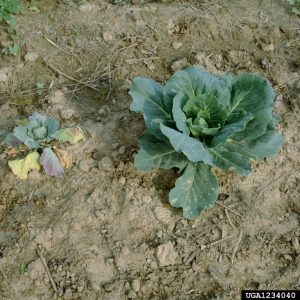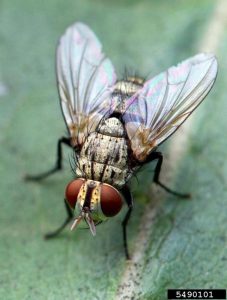Spruce bark beetles aren’t going to take out your prized peonies or decimate your potato crop but they can have devastating impacts on your property, and if you are managing a woodlot, could impact future harvests.
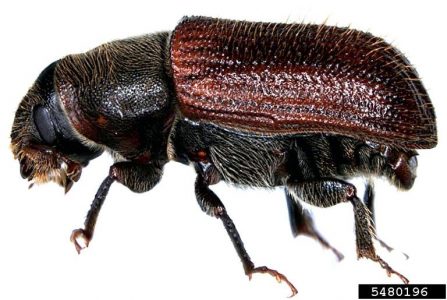
Spruce bark beetle adult. Adults are approximately 1/4inch long and reddish-brown to black. Photo by M. O’Donnell and A. Cline, Wood Boring Beetle Families, USDA APHIS ITP, Bugwood.org
Spruce bark beetles are small, cylindrical beetles that tunnel beneath the bark of spruce trees. Adult beetles bore through the bark, where they lay eggs and feed in the tissue responsible for transporting sugars produced in the needles down to the roots of the tree. Spruce bark beetles prefer to attack large, weakened or stressed trees. They are commonly attracted to areas of wind damage due to the large amounts of downed material that serves as a great host. In living, standing trees, damage from the spruce bark beetle cuts off the tree’s ability to feed itself and the tree dies.
As a native pest, spruce bark beetles are always present in the environment. They usually exist at low-level populations in downed and damaged material. Under the right conditions, however, spruce bark beetle populations can build up, resulting in outbreaks.

Spruce trees killed by spruce bark beetle. Photo by Daniel Miller, USDA Forest Service, Bugwood.org
Signs and symptoms of spruce bark beetle infestation
Early evidence of an infestation can include:
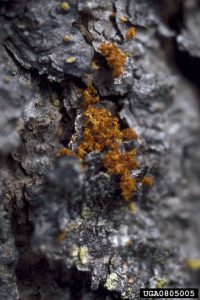
Spruce bark beetle boring dust on bark. Photo by Edward H. Holsten, USDA Forest Service, Bugwood.org
Boring dust: This dust is the result of the beetles boring into the tree. This material is pushed or falls out of the entrance hole and collects around the bark or base of the tree.
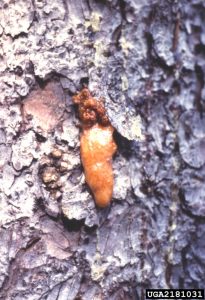
Spruce bark beetle pitch tube. Photo by Darren Blackford, USDA Forest Service, Bugwood.org
Pitch tubes: Pitch tubes are the tree’s efforts to physically push the beetles out with excessive pitch. The tree pitch is often combined with the boring dust created by the beetles giving the tubes a reddish-brown color.
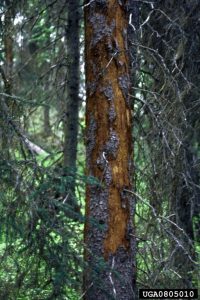
Woodpecker bark removal on a spruce bark beetle infested tree. Photo by Edward H. Holsten, USDA Forest Service, Bugwood.org
Woodpecker activity: Woodpeckers are often attracted to trees infested with bark beetles and other wood-boring insects. Woodpeckers flake away bark to gain access to the beetles underneath. Flaked bark on the ground is usually observed in the winter and spring.
Sometimes this evidence is not visible or noticed. Trees that are heavily drought stressed may not produce pitch tubes and boring dust can be blown away in heavy winds. Leaf discoloration may be the first evidence of infestation that is noticed. Needles on trees infested by spruce bark beetles usually go from green to yellow to reddish brown. This may occur in a single growing season or may not happen until the following season. As a caution, leaf discoloration can be caused by several factors including insects, disease, and environmental stress. Change in needle color does not automatically indicate a spruce bark beetle infestation.
Management options
In woodlots and forests, the best way to manage spruce bark beetles, and other forest or tree health pests, is to manage for overall forest health.
- Thin stands to reduce competition and encourage diversity of age classes.
- Clean up debris after storm events.
- Avoid unnecessary injury to trees.
Once a tree has been attacked by spruce bark beetles, there are few options available for that specific tree. Instead, measures should be taken to prevent the beetles spreading to nearby trees, including:
- Remove the infested tree from the area.
- Avoid cutting and injuring trees (including pruning) during the active adult flight period from May to July.
- Water trees during excessive dry spells, if feasible.
- Avoid stacking spruce firewood near live spruce trees.
For high-value landscape trees preventive sprays may be used to protect uninfested trees on your property.
- Sprays should be done in spring before the adult flight period.
- Treatments should be made to the trunk of the tree up to 25 feet.
- Insecticides containing carabryl and pyrethroids are effective in killing adults as they attack trees.
Insecticides will not cure trees that are already attacked by spruce bark beetles and if timed or applied incorrectly will not prevent a tree from being attacked. Read and follow all label directions for any pesticide product, and observe all safety precautions. For more information on pesticides, contact your local Cooperative Extension Service office.
For more information about spruce bark beetles and how to manage them, check out these resources:

